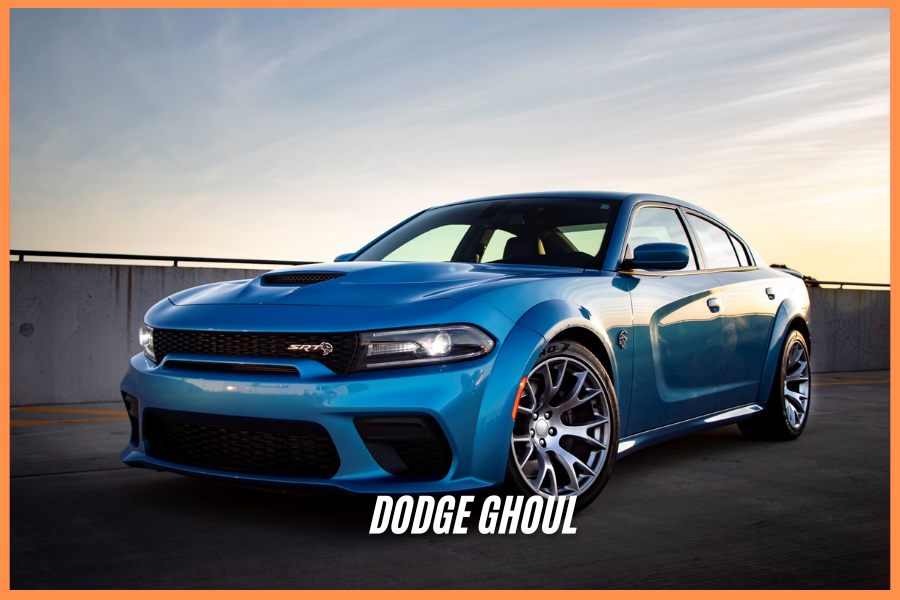In the realm of high-performance muscle cars, few brands command as much respect and attention as Dodge. Known for their power-packed vehicles, Dodge has become a symbol of raw automotive performance. Among the many models the company has introduced, one name has sparked the curiosity of car enthusiasts around the world: the Dodge Ghoul. But what is the SRT Ghoul, and why has it gained so much attention? While this name may conjure up images of an extraordinary, high-performance machine, the truth behind the Dodge SRT Ghoul is not as straightforward as it may seem.
The Origins of the Dodge Ghoul
The “SRT Ghoul” was first introduced to the automotive world on April 1, 2021, in what could be considered one of the best April Fool’s Day jokes ever. CarBuzz, an automotive news website, published an article about the Dodge Charger SRT Ghoul, a car said to feature a 1,000-horsepower engine and a hefty price tag of $200,000. This fictional vehicle was described as a souped-up version of the already formidable Dodge Charger, equipped with a monstrous engine capable of outrunning any competition.
The SRT Ghoul was described as being a more extreme and powerful model than the Dodge Demon and Hellcat, which were already known for their impressive performance figures. According to the article, the Ghoul would take the Charger to the next level, with an engine that could produce an insane 1,000 horsepower. Additionally, the car was said to have a stripped-down design that focused purely on performance, with a minimalistic interior and aggressive aerodynamics. Of course, the entire article was a playful jab at the increasing trend of high-performance muscle cars, but it didn’t take long for people to start wondering: Could the SRT Ghoul actually be real?
Wiki
| Attribute | Details |
| Model Name | Dodge SRT Ghoul |
| Manufacturer | Dodge |
| Engine Power | 1,000 horsepower (fictional) |
| Engine Type | Supercharged V8 (concept) |
| Performance | 0-60 mph in under 2.5 seconds (fictional) |
| Production Status | Not in production (April Fool’s Day joke) |
| Introduction | April 1, 2021 (April Fool’s Day article by CarBuzz) |
| Price (Estimated) | $200,000 (fictional) |
| Design | Aggressive styling, stripped-down interior (concept) |
| Body Style | Sedan (based on Dodge Charger) |
| Transmission | Not specified (fictional) |
| Top Speed | Estimated 200+ mph (fictional) |
| Target Market | High-performance enthusiasts, muscle car lovers |
| Key Features | High-performance engine, aggressive styling, minimal interior |
| Real-World Equivalent | Dodge Charger SRT, Dodge Challenger SRT, Dodge Demon |
The Myth Grows: Speculation and Discussions
Although it was intended as an April Fool’s joke, the concept of the SRT Ghoul quickly gained traction in the automotive world. Car enthusiasts, media outlets, and even casual readers started discussing the possibility of such a vehicle. After all, Dodge had already pushed the boundaries with models like the Hellcat and Demon, both of which redefined what was possible in the muscle car world.
As the myth of the SRT Ghoul spread, many speculated that Dodge could eventually create a production version of the car, based on the massive interest it garnered. The idea of a 1,000-horsepower Charger seemed like the natural next step for the brand, especially when considering its legacy of producing some of the most powerful vehicles on the road. This speculation fueled even more excitement, leading to discussions across online forums, social media, and even automotive news websites.
While the Ghoul might have been a fictional creation, the reactions it received highlighted a growing demand for hyper-performance muscle cars. The automotive world, particularly muscle car enthusiasts, were eager for something new and more extreme than what was currently available. The SRT Ghoul, with its exaggerated specifications, was the perfect embodiment of these desires.
Debunking the Myth: The Real Story
As time went on, it became clear that the Dodge SRT Ghoul was not going to be a reality. Dodge, known for producing muscle cars with outrageous power numbers, made no indication that they were planning to release such a model. Instead, the SRT Ghoul remained firmly in the realm of speculation and wishful thinking.
The main reason the SRT Ghoul couldn’t become a reality lies in the practicality of creating a 1,000-horsepower production car. While the idea of such a powerful engine in a production car is certainly appealing, it would present a number of challenges for Dodge. First and foremost, the SRT Ghoul’s proposed engine, the Hellephant, is a crate engine designed for aftermarket use, not for mass production. The Hellephant engine, though powerful, does not meet current emission standards, making it unsuitable for modern-day road cars. Furthermore, the engine’s size and power output would require significant adjustments to the car’s chassis and drivetrain, making it an impractical option for a mass-market production vehicle.
Additionally, creating a car with 1,000 horsepower would demand significant modifications to other aspects of the vehicle. For instance, the suspension, brakes, and transmission would all need to be designed to handle the immense power of such an engine. This would result in a car that would be prohibitively expensive to produce and purchase, likely far beyond the price point that would make it a viable option for most consumers.
Given these factors, it became clear that the SRT Ghoul, as it was originally described, was never going to be a production car. While the idea of a 1,000-horsepower muscle car remains appealing, the technical and financial hurdles make it an unrealistic option for most car manufacturers, including Dodge.
Dodge’s Actual Plans: What’s Next for Muscle Cars?
While the SRT Ghoul may have been a joke, Dodge’s commitment to high-performance vehicles is very much real. The company has continued to push the envelope with cars like the Dodge Challenger Hellcat and the Charger SRT models, both of which offer mind-blowing horsepower figures and thrilling performance. However, Dodge is also looking towards the future of muscle cars, including the transition towards electrification.
One of the most exciting developments in Dodge’s lineup is the upcoming 2025 Dodge Charger Sixpack. Unlike the mythical Ghoul, this vehicle is based on real plans and will offer a balance of performance and innovation. The Charger Sixpack will be powered by a 3.0-liter twin-turbocharged inline-six engine, available in two trims: one producing 420 horsepower and the other delivering 550 horsepower. This engine will bring a new level of performance to the Charger, offering buyers a high-performance option that blends muscle car tradition with modern technology.
In addition to the performance of the Sixpack, Dodge is also embracing electrification. The company has already announced plans to release a fully electric muscle car in the coming years, aimed at combining the classic power and style of muscle cars with the efficiency and sustainability of electric vehicles. This move reflects Dodge’s recognition of the changing automotive landscape, where electrification is becoming increasingly important.
The Legacy of the SRT Ghoul: What it Represents
Although the SRT Ghoul will never become a reality, its existence—at least as a concept—has had a lasting impact on the automotive community. The Ghoul, as a mythical vehicle, represents the insatiable desire for extreme performance and the future of muscle cars. It embodies the dream of car enthusiasts who want to push the limits of speed, power, and design. Even though it was never intended to be more than a joke, the Ghoul has sparked conversations about what the future holds for high-performance vehicles.
The myth of the SRT Ghoul also speaks to the growing popularity of hyper-performance cars, which continue to captivate car lovers around the world. From Dodge’s Demon to the growing trend of electric performance vehicles, there is no doubt that the desire for more powerful and capable cars is not going anywhere. The SRT Ghoul, while a fictional creation, has only served to fuel this desire further, pushing the boundaries of what is possible in the muscle car world.
Dodge’s Muscle Car DNA: From the Hellcat to the Future
Dodge has a long and storied history of producing some of the most iconic muscle cars ever built. From the legendary Dodge Charger to the Challenger Hellcat, the brand has established itself as a leader in the performance car world. The Hellcat, with its 707-horsepower engine, was one of the most powerful production cars on the market, while the Dodge Demon pushed the limits even further with its 840 horsepower. These cars have become symbols of raw, unfiltered power, and they continue to be beloved by car enthusiasts worldwide.
But as the automotive industry shifts toward more sustainable technologies, Dodge is adapting to meet the demands of the future. The upcoming Charger Sixpack and the electric muscle car in the works are just the beginning of this new chapter in Dodge’s history. While the SRT Ghoul may have been a fictional car, its spirit of extreme performance will continue to influence the development of future vehicles from the brand.
The Importance of the SRT Ghoul’s Influence
While the Dodge Ghoul may never hit the streets, the discussions it has generated are invaluable. They have sparked conversations about the direction of the muscle car industry, encouraging manufacturers to think bigger and bolder when it comes to performance. The Ghoul’s legacy, as a symbol of extreme power, will undoubtedly continue to inspire both car manufacturers and enthusiasts alike. Whether it’s through the development of more powerful internal combustion engines or the adoption of electric technology, the influence of the SRT Ghoul lives on.
Conclusion
The “Dodge Ghoul” may have started as an April Fool’s joke, but its impact on the automotive world has been undeniable. This mythical muscle car concept, with its 1,000-horsepower engine and extreme performance potential, captured the imagination of car enthusiasts worldwide. Although the SRT Ghoul never made it to production, the conversations it sparked about extreme performance and the future of muscle cars remain significant. It highlighted the growing desire for more power and innovation within the automotive community, and even though Dodge has yet to release such a car, the spirit of the Ghoul lives on in the brand’s current and future models. As the automotive industry shifts toward electric vehicles and more sustainable options, muscle car fans can rest assured that Dodge’s legacy of powerful, high-performance vehicles will continue to evolve, whether through traditional engines or cutting-edge technology.
FAQs
What is the Dodge Ghoul?
The Dodge Ghoul was initially introduced as a fictional concept in an April Fool’s Day article by CarBuzz. It was described as a 1,000-horsepower muscle car based on the Dodge Charger, but it has never been produced by Dodge.
Will Dodge ever release the SRT Ghoul?
While the SRT Ghoul was a joke, Dodge has not announced any plans to release a car with 1,000 horsepower. However, the brand continues to push the boundaries of performance with models like the Charger SRT and the upcoming electric muscle car.
What is the most powerful Dodge car?
As of now, the most powerful Dodge car is the Dodge Challenger SRT Demon, which boasts 840 horsepower. It holds the record for the most powerful production muscle car.
Why did the Dodge SRT Ghoul get so much attention?
The Dodge Ghoul gained attention because it pushed the limits of performance, with a fictional 1,000-horsepower engine. The idea of such a powerful muscle car captured the imagination of car enthusiasts, sparking discussions about what the future of high-performance vehicles could look like.
Is Dodge moving towards electric vehicles?
Yes, Dodge has announced plans to release a fully electric muscle car in the future. The company is exploring new technologies while still maintaining its commitment to high-performance vehicles, blending tradition with innovation.
Discover the latest news and updates on Magazine Format




